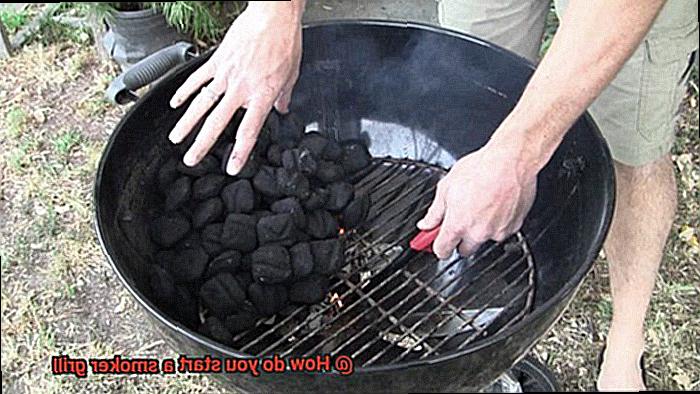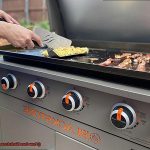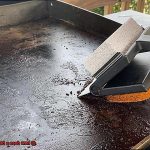Imagine this: it’s a balmy summer evening, the air is thick with the scent of freshly cut grass and sizzling meat. Your friends and family are gathered around, eagerly anticipating the mouthwatering smoky flavor that only a smoker grill can provide. But there’s one problem – you have no clue where to start. Fear not, my friend, because we’ve got your back.
Starting a smoker grill can be intimidating, especially if you’re new to the art of barbecuing. But with just a few simple steps, you’ll have your smoker fired up and ready to go in no time. First things first – choose the right wood chips to achieve the flavor profile you want. Then, prep your smoker by giving it a thorough clean and making sure it’s good to go.
Next up: creating a fire in your smoker. Don’t be afraid to use newspaper or kindling to help get things started – after all, Rome wasn’t built in a day. Once your fire is roaring, add those wood chips into the mix and let them work their magic.
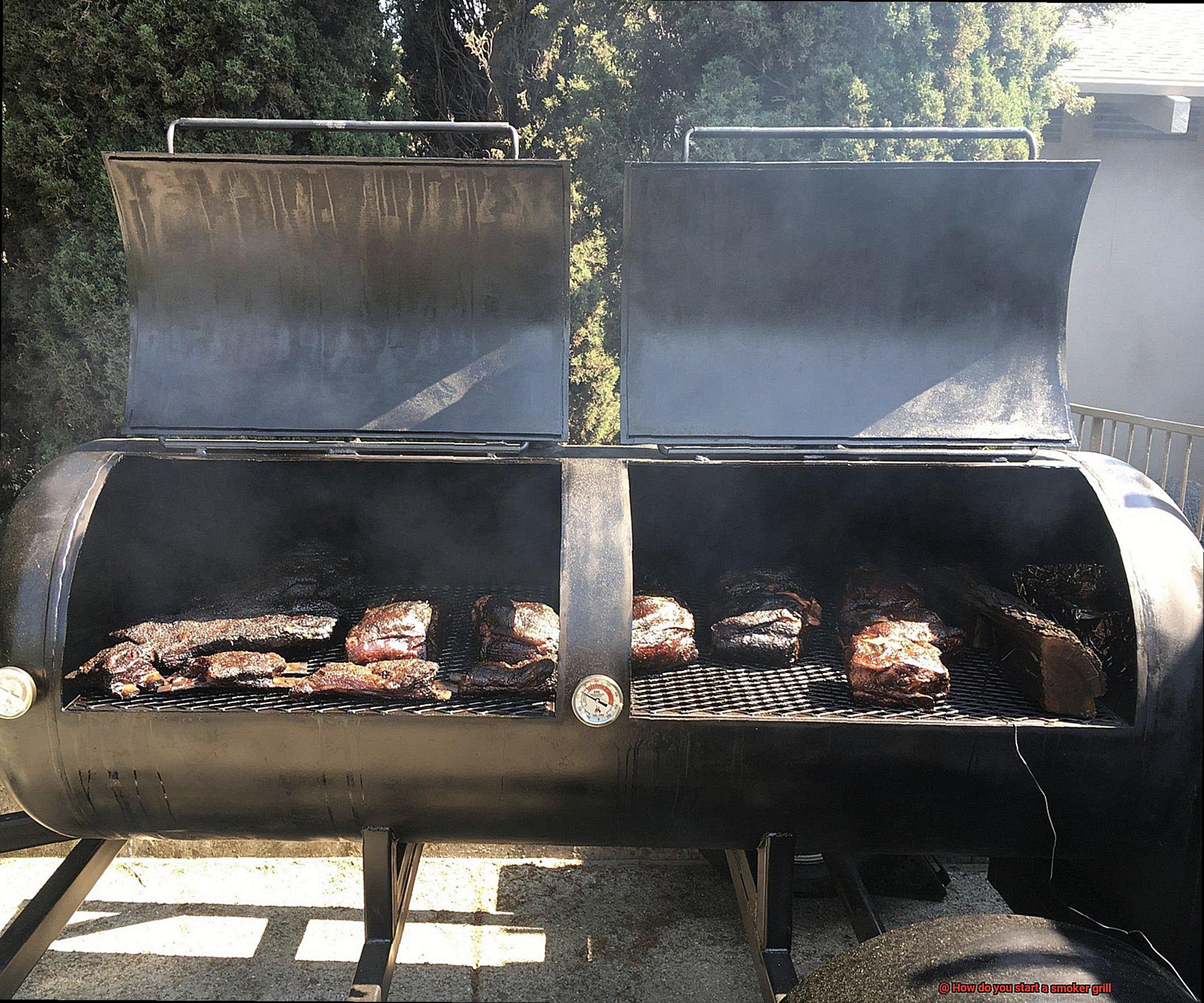
But wait, there’s more. Smoking meat is an art form that requires precision and finesse. Controlling the temperature is key to achieving that perfect smoky taste sensation. And don’t forget about choosing the right cuts of meat for smoking – some meats are better suited than others.
In this blog post, we’ll cover everything you need to know about starting up your smoker grill like a pro – from selecting wood chips to controlling temperature and choosing meats that will make your taste buds sing with joy. So grab those tongs and apron, my friend – it’s time to wow your guests with some seriously delicious barbecue.
Contents
Choosing the Right Wood Chips or Charcoal
Starting your smoker grill with the right wood chips or charcoal is the key to achieving the perfect smoky and delicious flavor for your meats. The type of wood chips or charcoal you use can greatly impact the taste and aroma of your food.
When it comes to wood chips, there are different types available, each with its unique flavor profile. Hickory wood chips have a strong and smoky flavor that pairs well with beef and pork, while apple wood chips have a sweet and fruity taste that complements poultry and fish. Other popular wood chip types include mesquite, oak, and fruitwoods such as cherry. Selecting a wood chip that enhances the natural flavors of the meat you will be grilling is crucial for a successful smoking experience.
Charcoal, on the other hand, is made by burning wood until it turns into carbon. High-quality hardwood charcoal is recommended to ensure a clean burn and avoid chemical additives. Charcoal provides a consistent heat source and burns longer than traditional wood chips. However, it doesn’t add as much flavor as wood chips do.
When deciding between wood chips and charcoal, it ultimately comes down to personal preference and the type of meat you will be grilling. Some people prefer the robust flavor profile that wood chips provide, while others opt for the convenience of charcoal.
Now that you know the difference between wood chips and charcoal let’s talk about how to prepare your smoker grill. Before starting, make sure you have all the necessary tools and ingredients ready, such as the smoker grill, charcoal or wood chips, lighter fluid or electric starter, and meat.
To start your smoker grill, begin by cleaning it thoroughly. Remove any leftover ash from previous cooking sessions and clean the grates to ensure they’re ready for use. Next, arrange the charcoal or wood chips in a pile in the center of the grill. Ensure there’s enough space around the edges for air to circulate.
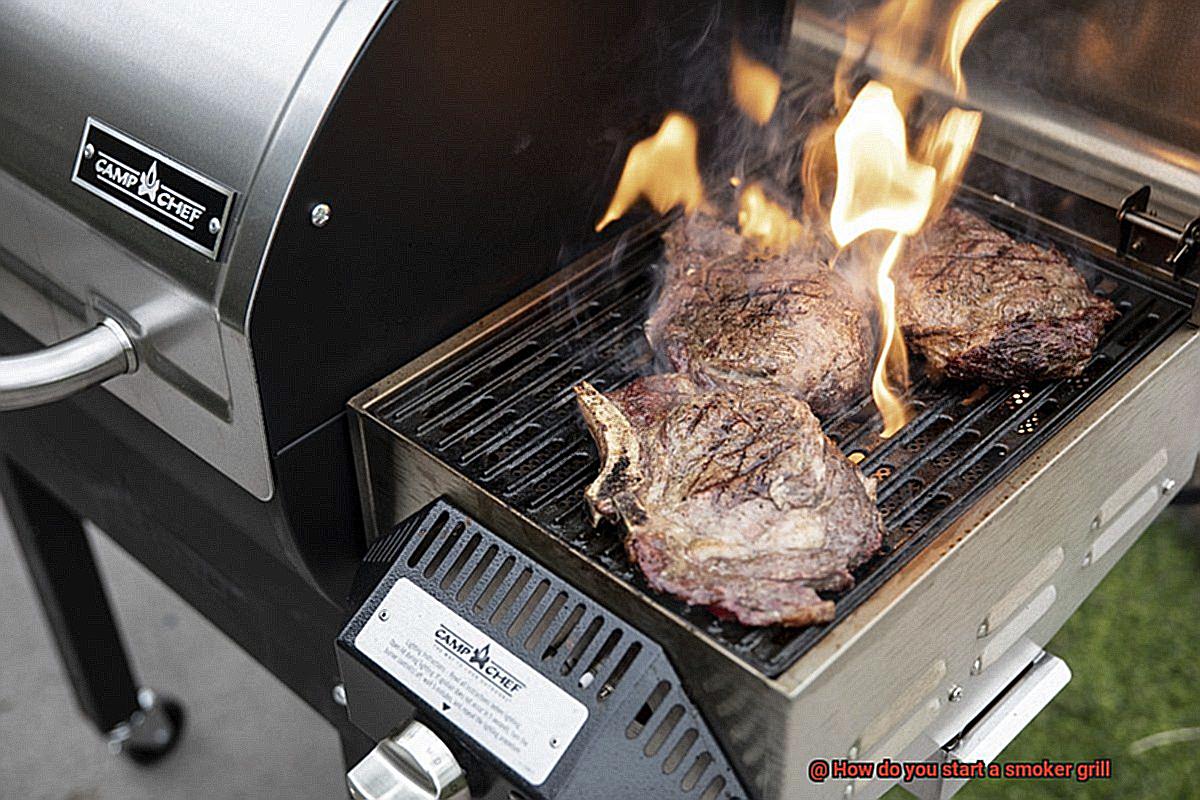
If you’re using charcoal, add lighter fluid to the pile and let it soak for a few minutes. Then, light the pile using a long match or lighter. If using an electric starter, place it under the charcoal and turn it on until the coals are hot.
Once the coals are lit, wait for them to turn white and ashy before placing the meat on the grill. This usually takes about 20-30 minutes. If using wood chips, place them on top of the coals before adding the meat.
Preparing the Grill
Preparing the grill is a crucial step that guarantees your grill is clean, safe, and ready for cooking. Here are some essential steps you must follow before starting your next grilling session.
Firstly, it’s imperative to clean the grill thoroughly. No one wants their food to taste like the ashes of previous grilling sessions. Use a brush or scraper to remove any debris or ash from the grill’s firebox. This will ensure that your grill is free from any leftover charcoal or ashes. A clean grill also prevents any unwanted flavors from transferring onto your food.
Secondly, check the fuel source. Before starting the grill, make sure you have enough fuel to last throughout your cooking marathon. Charcoal grills require sufficient charcoal to start the fire, while gas grills need a full propane tank or natural gas line. Ensure that there is enough fuel to last throughout your cookout so that you don’t run out midway through cooking.
Thirdly, proper airflow is vital for maintaining proper cooking temperatures on your grill. Check the vents to ensure they’re open and unblocked before starting your cookout. This will allow your meat to cook evenly and retain its moisture throughout the cooking process, resulting in perfectly juicy and tender meats.
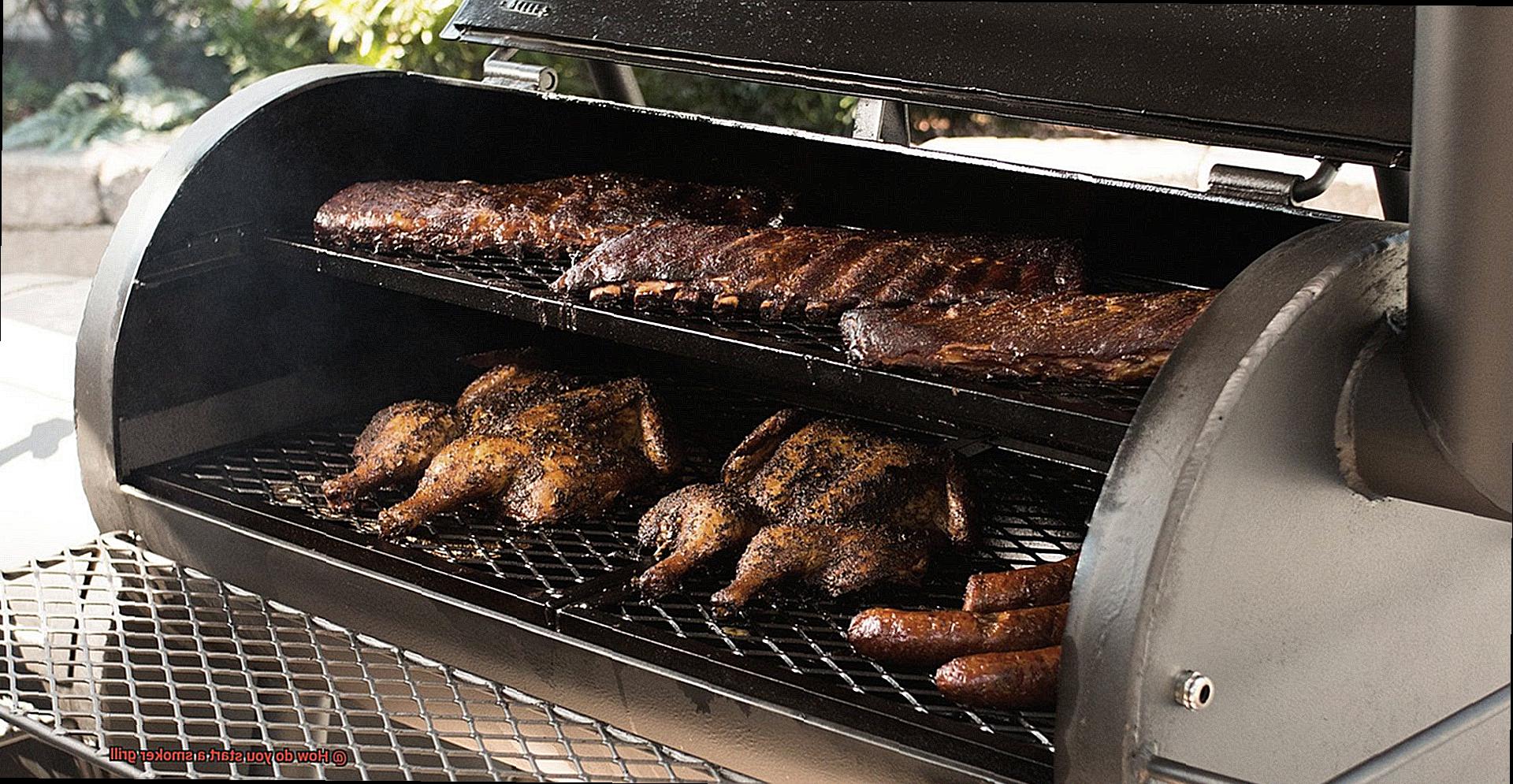
Lastly, oiling the grill grates is essential to prevent food from sticking onto them. Use a high smoke point oil like vegetable or canola oil and apply it evenly over the grates using a brush or paper towel. This will ensure that your food doesn’t stick onto the grates and looks beautiful when served.
Lighting the Coals
Then, let’s dive into the essential steps for lighting the coals on your smoker grill. As an expert in the field, I’m here to guide you through the process and share some pro tips along the way.
First off, selecting the right type of charcoal is crucial. You have two main options: briquettes or lump charcoal. Briquettes are made from compressed sawdust and other materials, while lump charcoal is made from natural hardwood. Which one you choose depends on your personal preference and desired flavor profile.
Once you’ve chosen your charcoal, it’s time to start lighting those coals. The easiest and most efficient way to do this is by using a chimney starter. This handy tool is a metal cylinder with a handle on the side and a grate at the bottom. Fill it with charcoal and then light a piece of newspaper or a fire starter underneath it. The heat will rise up through the chimney, evenly lighting all of the coals.
But here’s a pro tip: be mindful not to overfill your chimney starter as this can cause uneven ignition, resulting in hot spots on your grill. A general rule of thumb is to fill it about three-quarters of the way full for optimal results.
Patience is key when waiting for your coals to be ready for cooking. Be sure to wait until they’re covered with a layer of white ash before placing your meat on the grill. This can take anywhere from 20-30 minutes, depending on various factors such as how much charcoal you’re using and how windy it is outside.
One critical point to remember when lighting your coals is to avoid using lighter fluid or other chemical starters. These can leave an unpleasant chemical taste on your food and pose a danger if not used correctly. Stick with natural methods like newspaper or fire starters for the best taste and safety.
Adding the Meat to the Grill
Adding meat to a smoker grill may seem like a daunting task, but with a little know-how, you can create delicious, mouth-watering smoked meats that will impress everyone around the table.
First off, timing is everything when it comes to smoking meat. Ensure that your grill is at the right temperature before adding your meat. For most meats, the temperature should be between 225-250°F. In addition, having the right amount of fuel and wood chips in your smoker grill is crucial.
To truly elevate the flavor of your meat, rub it down with your favorite seasoning or marinade before placing it on the grill grates. This step will add depth and complexity to your dish. Once seasoned, place your meat on the grates and close the lid to let the smoker work its magic.
While cooking, keep an eye on the temperature of your smoker grill and adjust as necessary by adding more fuel or wood chips. To ensure even cooking, flip your meat occasionally.
The cook time of your meat will vary depending on its type and thickness, so don’t forget to use a meat thermometer to check for doneness. Beef and pork should reach an internal temperature of at least 145°F, while poultry should reach 165°F.
Once your meat has reached its desired internal temperature, remove it from the grill and let it rest for a few minutes before serving. This step is essential as it allows the juices to redistribute throughout the meat, ensuring that every bite is moist and flavorful.
Monitoring the Temperature
Well, it all starts with monitoring the temperature when smoking meat on a smoker grill. Achieving the ideal temperature is key to creating a masterpiece that will tantalize your taste buds and make you the envy of your friends.
To begin with, investing in a good quality thermometer is essential. A thermometer is a vital tool in monitoring the temperature of the smoker grill. With several types of thermometers available in the market, such as digital thermometers that are easy to read and provide accurate measurements, keeping track of the temperature has never been easier. By using a thermometer, you can ensure that your smoker grill maintains a consistent temperature throughout the cooking process.
In addition to using a thermometer, understanding the ideal temperature range for different types of meat is critical. Each type of meat requires a specific temperature range to achieve perfection. For instance, beef brisket should be smoked at a temperature range of 225-250°F, while pork ribs should be cooked at 225°F. Knowing these temperature ranges ensures that your meat is cooked to perfection and avoids overcooking or undercooking.
Another tip for maintaining a consistent temperature while smoking meat is using a water pan in your smoker grill. The water in the pan helps regulate the temperature by absorbing and releasing heat as needed. It also ensures that there’s a moist environment inside the smoker grill, which is essential for smoking meat.
Lastly, keep an eye on the smoke coming out of the smoker grill. A healthy amount of smoke is required for smoking meat, but too much or too little could indicate that the temperature is too high or too low. Checking on the smoke helps you adjust the temperature accordingly and ensure that your meat is perfectly cooked.
Tips for Successful Smoking
Smoking meat is an art form that requires patience, skill, and attention to detail. To ensure your smoking experience is successful and results in mouth-watering, perfectly cooked meat, it’s essential to follow these key tips.
Choose the Right Wood
The wood you use for smoking plays a significant role in the flavor profile of your meat. Hickory, for example, provides a strong and smoky flavor, while cherry wood offers a milder and sweeter taste. Experiment with different types of wood to find the perfect match for your meat.
Don’t Overdo It
It’s tempting to keep adding wood to your smoker to intensify the flavor, but over-smoking can ruin your meat. Too much smoke can result in an acrid and bitter taste that no amount of seasoning can fix. Stick to smoking your meat for no more than 4-6 hours for optimal results.
Keep the Temperature Consistent
Maintaining a consistent temperature throughout the smoking process is crucial. Fluctuations in temperature can lead to uneven cooking and dry out your meat. Use a thermometer to ensure the temperature stays between 225-250 degrees Fahrenheit, ideal for producing tender and juicy meat.
Use a Meat Thermometer
Using a meat thermometer is essential when smoking meat. It allows you to monitor the internal temperature of your meat and determine when it’s cooked to perfection. This helps avoid under or overcooking your meat, resulting in a perfectly smoked piece every time.
Let the Meat Rest
After removing your smoked meat from the smoker, resist the urge to cut into it right away. Letting the meat rest for at least 10-15 minutes allows its juices to redistribute throughout, producing tender and flavorful results.
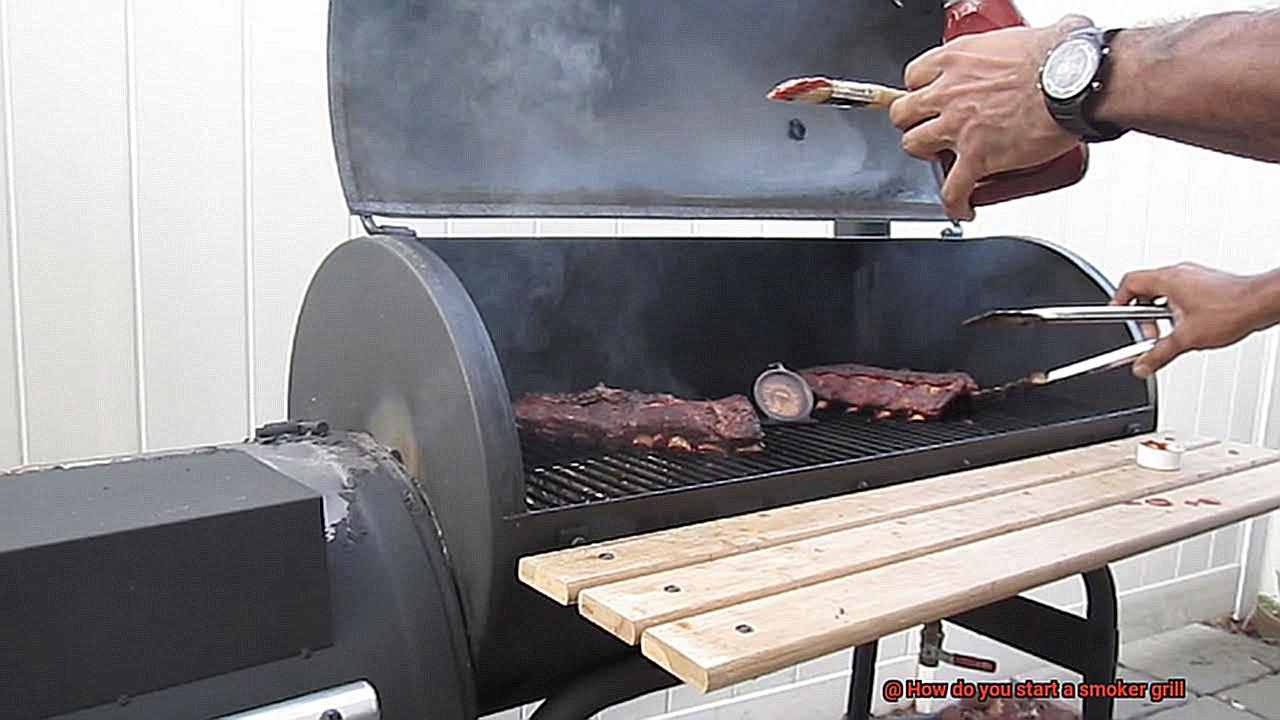
Practice Patience
Smoking meat is a slow process that requires patience. Allow yourself ample time to smoke your meat correctly, starting early in the day and leaving several hours for cooking. Trust the process and resist the temptation to rush it; your taste buds will thank you.
Troubleshooting Common Problems
First up, getting the fire started. This can be a frustrating problem, but don’t worry, it happens to everyone. To get those coals burning evenly, make sure to use enough lighter fluid. Let it soak in for a couple of minutes before lighting them up, and you’ll be well on your way to deliciously smoked meats.
Temperature control is crucial for a successful smoking session. If your smoker grill isn’t holding a steady temperature, it could be due to several factors. Check that you have enough fuel and that it’s burning evenly. Then, make sure the air vents are open and positioned correctly for proper airflow.
Another issue that can ruin the flavor of your smoked meats is producing too much smoke. To avoid this problem, use the right type of wood chips or chunks for your smoker grill and monitor the amount of smoke being produced. Adjust accordingly to achieve the perfect smoky flavor.
Uneven cooking or longer cook times can also be a problem. This may be due to uneven heat distribution or inadequate insulation. Try rotating the food around on the grill grates or investing in a high-quality smoker grill with better insulation.
rHDdem7n1Lo” >
Conclusion
In conclusion, mastering the art of starting a smoker grill may seem daunting at first. However, with the right tools and techniques, anyone can become a pro. The key to achieving that perfect smoky flavor for your meats lies in selecting the right wood chips or charcoal.
Before lighting up your smoker grill, it’s essential to ensure proper airflow and clean it thoroughly. Once you’ve got everything set up, maintaining consistent heat throughout the smoking process is crucial to producing tender and juicy meat. This is where using a thermometer comes in handy.
To ensure successful smoking every time, remember to choose the right wood, avoid over-smoking, keep temperatures consistent, use a meat thermometer, let the meat rest before serving and be patient. If you encounter any common problems like getting the fire started or uneven cooking, don’t worry. Simple adjustments can solve these issues quickly.
With these tips in mind, you’ll be able to impress your friends and family with mouth-watering smoked meats that are sure to be a hit at any summer cookout.

